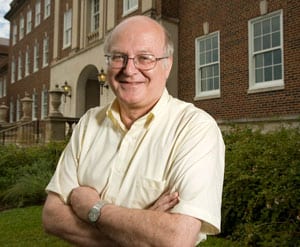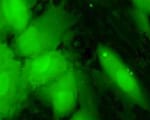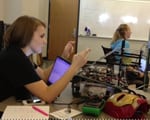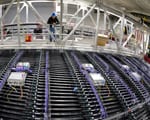SMU joins nearly 2,000 physicists from U.S. institutions — including 89 U.S. universities and seven U.S. DOE labs — that participate in discovery experiments
SMU’s experimental physics group played a pivotal role in discovering the Higgs boson — the particle that proves the theory for which two scientists have received the 2013 Nobel Prize in Physics.
The Royal Swedish Academy of Sciences today awarded the Nobel Prize to theorists Peter W. Higgs and François Englert to recognize their work developing the theory of what is now known as the Higgs field, which gives elementary particles mass. U.S. scientists played a significant role in advancing the theory and in discovering the particle that proves the existence of the Higgs field, the Higgs boson.
The Nobel citation recognizes Higgs and Englert “for the theoretical discovery of a mechanism that contributes to our understanding of the origin of mass of subatomic particles, and which recently was confirmed through the discovery of the predicted fundamental particle, by the ATLAS and CMS experiments at CERN’s Large Hadron Collider.”
In the 1960s, Higgs and Englert, along with other theorists, including Robert Brout, Tom Kibble and Americans Carl Hagen and Gerald Guralnik, published papers introducing key concepts in the theory of the Higgs field. In 2012, scientists on the international ATLAS and CMS experiments, performed at the Large Hadron Collider at CERN laboratory in Europe, confirmed this theory when they announced the discovery of the Higgs boson.
“A scientist may test out a thousand different ideas over the course of a career. If you’re fortunate, you get to experiment with one that works,” says SMU physicist Ryszard Stroynowski, a principal investigator in the search for the Higgs boson. As the leader of an SMU Department of Physics team working on the experiment, Stroynowski served as U.S. coordinator for the ATLAS Experiment’s Liquid Argon Calorimeter, which measures energy from the particles created by proton collisions.
The University’s experimental physics group has been involved since 1994 and is a major contributor to the research, the heart of which is the Large Hadron Collider particle accelerator on the border with Switzerland and France.
SMU joins nearly 2,000 physicists from U.S. institutions — including 89 U.S. universities and seven U.S. Department of Energy laboratories — that participate in the ATLAS and CMS experiments, making up about 23 percent of the ATLAS collaboration and 33 percent of CMS at the time of the Higgs discovery. Brookhaven National Laboratory serves as the U.S. hub for the ATLAS experiment, and Fermi National Accelerator Laboratory serves as the U.S. hub for the CMS experiment. U.S. scientists provided a significant portion of the intellectual leadership on Higgs analysis teams for both experiments.
Preliminary discovery results were announced July 4, 2012 at CERN, the European Organization for Nuclear Research, near Geneva, Switzerland, and at the International Conference of High Energy Physics in Melbourne, Australia.
“It is an honor that the Nobel Committee recognizes these theorists for their role in predicting what is one of the biggest discoveries in particle physics in the last few decades,” said Fermilab Director Nigel Lockyer. “I congratulate the whole particle physics community for this achievement.”
The majority of U.S. scientists participating in LHC experiments work primarily from their home institutions, remotely accessing and analyzing data through high-capacity networks and grid computing. The United States plays an important role in this distributed computing system, providing 23 percent of the computing power for ATLAS and 40 percent for CMS. The United States also supplied or played a leading role in several main components of the two detectors and the LHC accelerator, amounting to a value of $164 million for the ATLAS detector, $167 million for the CMS detector, and $200 million for the LHC. Support for the U.S. effort comes from the U.S. Department of Energy Office of Science and the National Science Foundation.
“It’s wonderful to see a 50-year-old theory confirmed after decades of hard work and remarkable ingenuity,” said Brookhaven National Laboratory Director Doon Gibbs. “The U.S. has played a key role, contributing scientific and technical expertise along with essential computing and data analysis capabilities — all of which were necessary to bring the Higgs out of hiding. It’s a privilege to share in the success of an experiment that has changed the face of science.”
The discovery of the Higgs boson at CERN was the culmination of decades of effort by physicists and engineers around the world, at the LHC but also at other accelerators such as the Tevatron accelerator, located at Fermilab, and the Large Electron Positron accelerator, which once inhabited the tunnel where the LHC resides. Work by scientists at the Tevatron and LEP developed search techniques and eliminated a significant fraction of the space in which the Higgs boson could hide.
Several contributors from SMU have made their mark on the project at various stages, including current Department of Physics faculty members Ryszard Stroynowski, Jingbo Ye, Robert Kehoe and Stephen Sekula. Faculty members Pavel Nadolsky and Fred Olness performed theoretical calculations used in various aspects of data analysis.
University postdoctoral fellows on the ATLAS Experiment have included Julia Hoffmann, David Joffe, Ana Firan, Haleh Hadavand, Peter Renkel, Aidan Randle-Conde and Daniel Goldin.
SMU has awarded eight Ph.D. and seven M.Sc. degrees to students who performed advanced work on ATLAS, including Ryan Rios, Rozmin Daya, Renat Ishmukhametov, Tingting Cao, Kamile Dindar, Pavel Zarzhitsky and Azzedin Kasmi.
Significant contributions to ATLAS have also been made by SMU faculty members in the Department of Physics’ Optoelectronics Lab, including Tiankuan Liu, Annie Xiang and Datao Gong.
“The discovery of the Higgs is a great achievement, confirming an idea that will require rewriting of the textbooks,” Stroynowski says. “But there is much more to be learned from the LHC and from ATLAS data in the next few years. We look forward to continuing this work.”
Higgs and Englert published their papers independently and did not meet in person until the July 4, 2012, announcement of the discovery of the Higgs boson at CERN. Higgs, 84, is a professor emeritus at the University of Edinburgh in Scotland. Englert, 80, is a professor emeritus at Universite Libre de Bruxelles in Belgium.
The prize was announced at 5:45 a.m. CDT on Tuesday, Oct. 8, 2013.
Follow SMUResearch.com on Twitter.
For more information, www.smuresearch.com.
SMU is a nationally ranked private university in Dallas founded 100 years ago. Today, SMU enrolls nearly 11,000 students who benefit from the academic opportunities and international reach of seven degree-granting schools. For more information see www.smu.edu.
SMU has an uplink facility located on campus for live TV, radio, or online interviews. To speak with an SMU expert or book an SMU guest in the studio, call SMU News & Communications at 214-768-7650.

 The Undying Radio: Familiarity breeds content when it comes to listeners and music
The Undying Radio: Familiarity breeds content when it comes to listeners and music Mosquito indexing system identifies best time to act against potential West Nile Virus outbreaks
Mosquito indexing system identifies best time to act against potential West Nile Virus outbreaks Sweden, SMU psychologists partner to launch parenting program that reduces child abuse
Sweden, SMU psychologists partner to launch parenting program that reduces child abuse Chemical probe confirms that body makes its own rotten egg gas, H2S, to benefit health
Chemical probe confirms that body makes its own rotten egg gas, H2S, to benefit health Study: High-volume Bitcoin exchanges less likely to fail, but more likely to suffer breach
Study: High-volume Bitcoin exchanges less likely to fail, but more likely to suffer breach Musicians who learn a new melody demonstrate enhanced skill after a night’s sleep
Musicians who learn a new melody demonstrate enhanced skill after a night’s sleep Study finds that newlyweds who are satisfied with marriage are more likely to gain weight
Study finds that newlyweds who are satisfied with marriage are more likely to gain weight Fruit flies fed organic diets are healthier than flies fed nonorganic diets, study finds
Fruit flies fed organic diets are healthier than flies fed nonorganic diets, study finds Center for Creative Leadership to study innovative learning method of SMU Lyle School of Engineering
Center for Creative Leadership to study innovative learning method of SMU Lyle School of Engineering NOvA neutrino detector in Minnesota records first 3-D particle tracks in search to understand universe
NOvA neutrino detector in Minnesota records first 3-D particle tracks in search to understand universe Parenting program tackles child abuse and neglect among formerly homeless families
Parenting program tackles child abuse and neglect among formerly homeless families Hiding in plain sight: How invisibility saved New Mexico’s Jicarilla Apache
Hiding in plain sight: How invisibility saved New Mexico’s Jicarilla Apache Study: Most Texas ISDs that are teaching the Bible are skirting 2007 state law
Study: Most Texas ISDs that are teaching the Bible are skirting 2007 state law